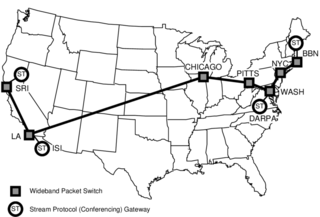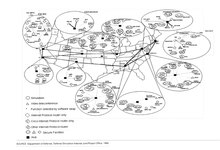
The Defense Advanced Research Projects Agency (DARPA) is a research and development agency of the United States Department of Defense responsible for the development of emerging technologies for use by the military.

In telecommunications, packet switching is a method of grouping data into packets that are transmitted over a digital network. Packets are made of a header and a payload. Data in the header is used by networking hardware to direct the packet to its destination, where the payload is extracted and used by an operating system, application software, or higher layer protocols. Packet switching is the primary basis for data communications in computer networks worldwide.
The end-to-end principle is a design framework in computer networking. In networks designed according to this principle, guaranteeing certain application-specific features, such as reliability and security, requires that they reside in the communicating end nodes of the network. Intermediary nodes, such as gateways and routers, that exist to establish the network, may implement these to improve efficiency but cannot guarantee end-to-end correctness.

Raytheon BBN is an American research and development company, based next to Fresh Pond in Cambridge, Massachusetts, United States.

The Advanced Research Projects Agency Network (ARPANET) was the first wide-area packet-switched network with distributed control and one of the first networks to implement the TCP/IP protocol suite. Both technologies became the technical foundation of the Internet. The ARPANET was established by the Advanced Research Projects Agency (ARPA) of the United States Department of Defense.

The Internet Stream Protocol (ST) is a family of experimental protocols first defined in Internet Experiment Note IEN-119 in 1979, and later substantially revised in RFC 1190 (ST-II) and RFC 1819 (ST2+). The protocol uses the version number 5 in the version field of the Internet Protocol header, but was never known as IPv5. The successor to IPv4 was thus named IPv6 to eliminate any possible confusion about the actual protocol in use.
Distributed Interactive Simulation (DIS) is an IEEE standard for conducting real-time platform-level wargaming across multiple host computers and is used worldwide, especially by military organizations but also by other agencies such as those involved in space exploration and medicine.
The Defense Information System Network (DISN) has been the United States Department of Defense's enterprise telecommunications network for providing data, video, and voice services for 40 years.
The Defense Data Network (DDN) was a computer networking effort of the United States Department of Defense from 1983 through 1995. It was based on ARPANET technology.
SIMNET was a wide area network with vehicle simulators and displays for real-time distributed combat simulation: tanks, helicopters and airplanes in a virtual battlefield. SIMNET was developed for and used by the United States military. SIMNET development began in the mid-1980s, was fielded starting in 1987, and was used for training until successor programs came online well into the 1990s.
The Aggregate Level Simulation Protocol (ALSP) is a protocol and supporting software that enables simulations to interoperate with one another. Replaced by the High Level Architecture (simulation) (HLA), it was used by the US military to link analytic and training simulations.

The Global Broadcast Service (GBS) is a broadcast service rapidly transferring information, which may be classified, for the U.S. Department of Defense (DoD) and its deployed and garrisoned units worldwide. Information may include video and digital data. GBS has become a critical piece of the DoD's intelligence, surveillance and reconnaissance architecture. An advancement in satellite communications, GBS fills two key military communications requirements:

Danny Cohen was an Israeli American computer scientist specializing in computer networking. He was involved in the ARPAnet project and helped develop various fundamental applications for the Internet. He was one of the key figures behind the separation of TCP and IP ; this allowed the later creation of UDP.

The Packet Radio Network (PRNET) was a set of early, experimental mobile ad hoc networks whose technologies evolved over time. It was funded by the Advanced Research Projects Agency (ARPA). Major participants in the project included BBN Technologies, Hazeltine Corporation, Rockwell International's Collins division, and SRI International.

The Terrestrial Wideband Network was a DARPA-sponsored experimental network designed to support research in high-speed networking protocols and distributed multimedia applications. It was built and operated by BBN Technologies from May 1989 to about 1991; although originally planned to turn into the Defense Research Internet, it instead evolved into the Defense Simulation Internet.

The ARPANET pioneered the creation of novel encryption devices for packet networks in the 1970s and 1980s, and as such were ancestors to today's IPsec architecture, and High Assurance Internet Protocol Encryptor (HAIPE) devices more specifically.
Chip Elliott is an American engineer, best known for his work in creating advanced computer networks.

The DARPA Quantum Network (2002–2007) was the world's first quantum key distribution (QKD) network, operating 10 optical nodes across Boston and Cambridge, Massachusetts. It became fully operational on October 23, 2003 in BBN's laboratories, and in June 2004 was fielded through dark fiber under the streets of Cambridge and Boston, where it ran continuously for over 3 years. The project also created and fielded the world's first superconducting nanowire single-photon detector. It was sponsored by DARPA as part of the QuIST program, and built and operated by BBN Technologies in close collaboration with colleagues at Harvard University and the Boston University Photonics Center.
The Internet of Military Things (IoMT) is a class of Internet of things for combat operations and warfare. It is a complex network of interconnected entities, or "things", in the military domain that continually communicate with each other to coordinate, learn, and interact with the physical environment to accomplish a broad range of activities in a more efficient and informed manner. The concept of IoMT is largely driven by the idea that future military battles will be dominated by machine intelligence and cyber warfare and will likely take place in urban environments. By creating a miniature ecosystem of smart technology capable of distilling sensory information and autonomously governing multiple tasks at once, the IoMT is conceptually designed to offload much of the physical and mental burden that warfighters encounter in a combat setting.











